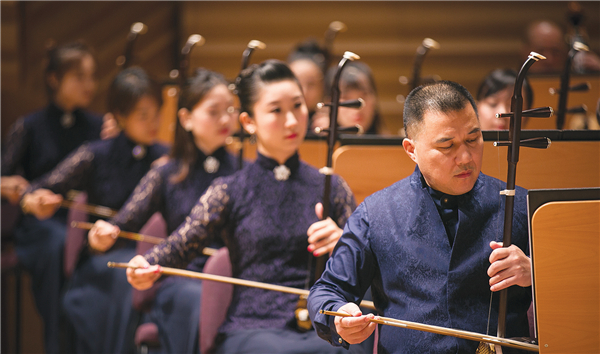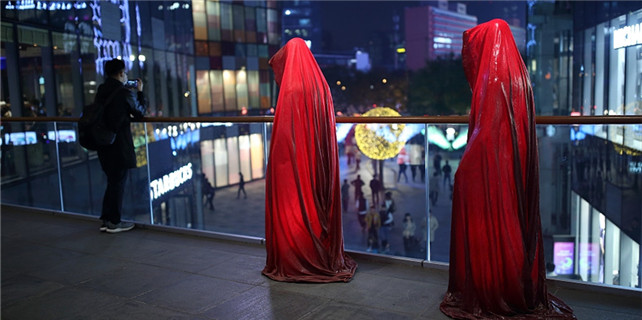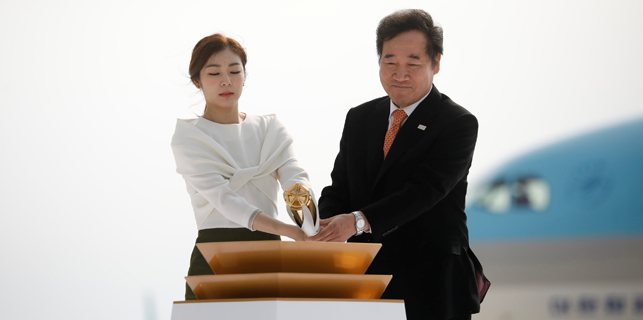A two-way exchange of art
 |
|
Musicians play folk music during the Shanghai Odyssey - The Bund performance. |
Of the 25 foreign productions presented at the CSIAF this year, one of the most highly anticipated is the one by Nederlands Dans Theater. The Dutch contemporary dance company made such a successful debut in Shanghai in 2014 that tickets for their three performances this year, scheduled to take place from Nov 3 to 5 at Shanghai Grand Theatre (SGT), were sold out weeks before the event, according to Zhang Xiaoding, general manager of SGT.
Sol Leon, the artistic advisor of the company, spoke about the creation of Safe as Houses, a dance inspired by the Chinese philosophical classic The Book of Changes. The Spanish dancer-turned-choreographer said she was influenced by Taoism ideas and poetry at a young age and that prompted her to work together with Paul Lightfoot, artistic director of the company, to create the piece in the music of Bach in 2001.
Wang Jianhui, the only Chinese dancer in the company, will be playing an important role in the piece. Wang joined the company seven years ago and started out with Nederlands Dans Theater's subsidiary NDTII. He later moved to the main company before picking up choreography skills.
When asked about his future plans, the 27-year-old said that he is eyeing a return to China following the end of his dancing career.
"We all know how dancers' careers can be short, and I hope to turn to choreography and continue on a different career path with dance companies in China," he said.
While many Chinese musicians have made inroads into the global art scene, dancers plying their trade in foreign companies are still few and far between. Wang Jie, the public relations officer of SGT, explained that this is because the Chinese dance community opened up relatively late to the world and there are fewer dance students compared to their musical counterparts.
However, thanks to the efforts of CSIAF and theaters such as SGT, a large number of internationally recognized dance companies have performed in the city. This has in turn resulted in the recruitment of more Chinese dancers in such companies, including the Martha Graham Dance Company and the Nederlands Dans Theater.
For example, Lou Menghan was the first Chinese dancer at NDT when the company first participated in the CSIAF in 2014. He later left the company to be a freelance choreographer. Earlier this year, Lou created a dance theater production for Shanghai Song and Dance Troupe titled The Red Curtain which premiered at the Shanghai International Dance Center in August.
Zhu Jiejing, director and leading dancer of the show, said she had Lou choreograph the piece in order to "explore the Chinese expression of contemporary dance".
"Menghan is different from us," Zhu said. "He has international vision. He doesn't expect dancers to be good students obeying orders, rather, he works with their mind to inspire their movements."
Contemporary dance productions in China tend to be "very Chinese", Lou said in an interview earlier this year with Shanghai-based news portal The Paper.
"Lots of the dancers started their training from traditional Chinese folk dance, and you can clearly trace their style and influence to that root. Also, Chinese audiences expect to see the story or plot in a dance show, but contemporary dance is more about an idea that has no limits," he said.
During CSIAF two years ago, Xin Ying was the only dancer from the Chinese mainland who performed for the Martha Graham Dance Company. She is now a principal dancer of the company and had flown to Shanghai in August to conduct a workshop on the Martha Graham techniques.
"I have benefited from the training system myself," Xin said. "It can be difficult for a Westerner to tell it to a Chinese, but I know I can explain it clearly. I can serve as a bridge.
"I hope to get more work done in China, and help more students," she added.
"Graham needs more talents, and I want to help nurture more dancers from China."
















